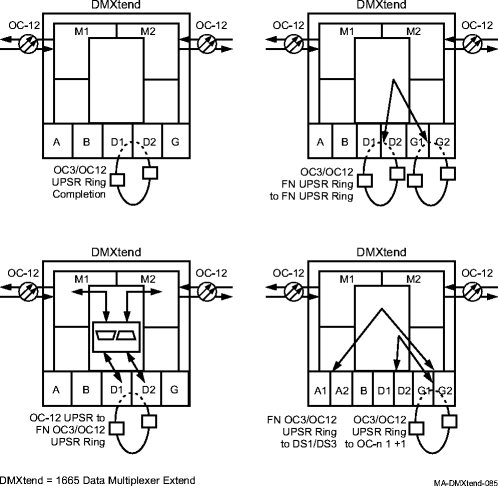Procedure 10-6: Make Function unit UPSR, hairpin, and Main to Function unit UPSR cross-connections
 Overview
Overview
Use this procedure as an example to provision certain types of cross-connections on a single Alcatel-Lucent 1665 Data Multiplexer Extend shelf. See Alcatel-Lucent 1665 Data Multiplexer Extend (DMXtend) TL1 Message Details, 365-372-328 for rates, types, restrictions, and allowable cross-connections. Note that E1 services require an STS-3c cross-connection.
This procedure is intended only to illustrate some of the many types of cross-connections, not to illustrate end-to-end service provisioning.
 Before you begin
Before you begin
Prior to performing this procedure:
-
Refer to Before you begin and Required equipment in this chapter.
-
Refer to Laser safety and Electrostatic discharge in Chapter 1, Safety.
-
Verify that the UPSR network configurations have been established using Procedure 9-7: Establish subtending low-speed UPSR, if required.
-
Determine the slots, circuit packs, ports, cross-connection types and cross-connection rates.
Steps
Complete the following steps to make the necessary cross-connections.
1 |
Refer to Figure 10-3, Cross-Connections examples for examples of some of the possible cross-connections. These examples show OC-12 optical rates in the Main slots and OC-3/12 optical rates in the Function/Growth slots. Other configurations with OC-3 in the Main slots and OC-3/12 in the Function/Growth slots are also applicable. These examples are only brief descriptions of possible cross-connections. Refer to Alcatel-Lucent 1665 Data Multiplexer Extend (DMXtend) TL1 Message Details, 365-372-328 for more information about allowable cross-connections. Figure 10-3: Cross-Connections examples |
2 |
On the System View menu, select Administration → OSI Routing Map to retrieve a node-to-node listing of every node in the network. Important! If a drawing of the network is not provided with the work instructions, it is recommended that you draw a simple diagram of the ring (indicating node-to-node connections) and list each node's TID. Result: The OSI Routing Map window opens. |
3 |
Verify that the ring configurations are the same as specified in the work instructions. Important! All differences between the work instructions and the actual ring configuration must be resolved before continuing. |
4 |
From the System View menu of the subject Alcatel-Lucent 1665 DMXtend node, select View → Equipment. Result: The View Equipment window opens. |
5 |
Find the circuit pack, port, and tributaries being used for this service. Select the entity to view, then click the Select button at the bottom of the window. View the provisioning details for the selected entity and verify the entities are properly provisioned. |
6 |
If the entities are not provisioned properly, use the procedures in this section to condition the circuit packs/ports for service. |
7 |
From your work instructions, determine the cross-connections to be made for the service being established. |
8 |
From the System View menu, select View → Cross-Connections to verify that the cross-connections specified on the work instructions may be made. If cross-connections are already assigned or improperly assigned, refer trouble to the provisioning organization. Improperly assigned cross-connections may have to be deleted, or a different timeslot must be selected for the service being selected. |
9 |
Select Configuration → Cross-Connections from the System View menu to start the Cross-Connection Wizard. |
10 |
In the Cross-Connection Wizard, select Create a new cross-connection, select the type of cross-connection, then follow the wizard directions. |
11 |
After all cross-connections have been made, verify that the channels have gone in service at each terminating node. From the System View menu at each terminating node, select View → Equipment. Result: The View Equipment window opens. Alarms are not reported until the channel state transitions to in-service (IS) which happens only when a good signal is received. Cross-connections create connections to both sides of the ring. The channel state will transition once a good signal is received on either side of the ring. |
12 |
Expand the details for the circuit pack being used. Select the required port, then click Select at the bottom of the window. Verify the port AID is correct at the top of the parameter display. |
13 |
Under Port Data/Fault in the parameter display, verify the Port Monitoring Mode is IS (in service). If the Port Monitoring Mode is IS, then Stop, you have completed this procedure. Otherwise, perform one of the following:
Reference: Alcatel-Lucent 1665 Data Multiplexer Extend (DMXtend) Alarm Messages and Trouble Clearing Guide, 365-372-326 End of steps |